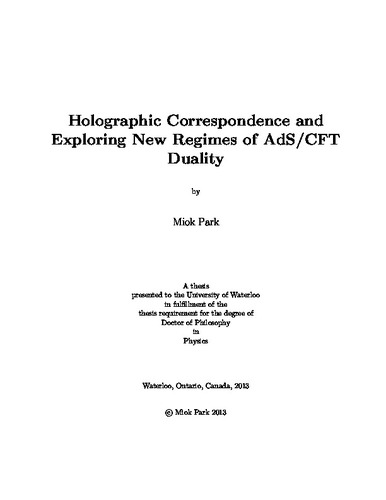| dc.description.abstract | We aim to have a comprehensive understanding of holographic correspondence and to demonstrate how the holographic correspondence (or renormalization) can be applied. Thus this thesis is divided into two parts. The first part is devoted to the former purpose (chapters 1 to 4 including appendix A,B, and C), and the second part is dedicated for the latter purpose (chapter 5 to 7).
In Part I, the structure of the AdS/CFT correspondence is analyzed, and the properties of the AdS spacetime is studied in the context of the AdS/CFT correspondence; Here, we investigate the isometry group, the conformal structure, and generation of asymptotic solution near the conformal boundary. This solution yields significant convenience for the process of holographic renormalization. Moreover the properties of the Minkowski spacetime are compared to those of the AdS spacetime. To develop a greater understanding of the Lifshitz/quantum critical theory correspondence, the quantum phase transition is studied. Furthermore The holographic renormalization is briefly reviewed.
In part II, the holographic renormalization associated with the Mann-Marolf (MM) counterterm is investigated for the asymptotically Minkowski spacetime in (n+3) dimensions. As a boundary condition, the cylindrical coordinate is considered. The solution of the MM-counterterm is obtained by solving the given algebraic equation, and from the counterterm solution, the boundary stress tensor is calculated. It is proven that the formula for conserved quantities via the boundary stress tensor holds.
Next, we investigate deformations of Lifshitz holography with the Gauss-Bonnet term in (n+1) dimensional spacetime. To admit the non-trivial solution of the sub-leading orders, a value of the dynamical critical exponent z is restricted by z= n-1-2(n-2)α̃, where is the (redefined) Gauss-Bonnet coupling constant. Such solution of sub-leading orders correspond to the marginally relevant modes for the massive vector field and are generated by Λ~0, at the asymptotic region. A generic black hole solution, which is characterized by the horizon flux of the vector field and α̃, is considered in the bulk. We explore its thermodynamic properties, which depend on temperature, by varying n and α̃. As a result, the contribution of the marginally relevant mode is found in a function of Λ^z/T, and the relation between the free energy density and the energy density is numerically recovered when the marginally relevant mode is turned off (Λ=0), is obtained. | en |

